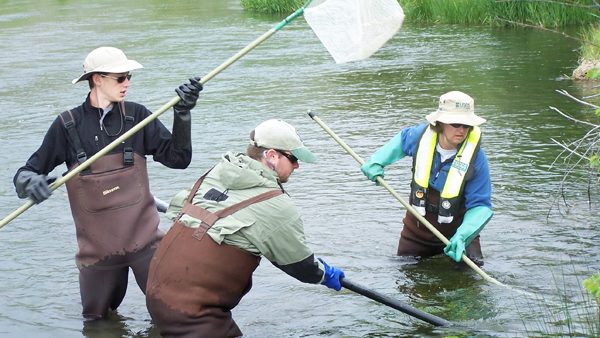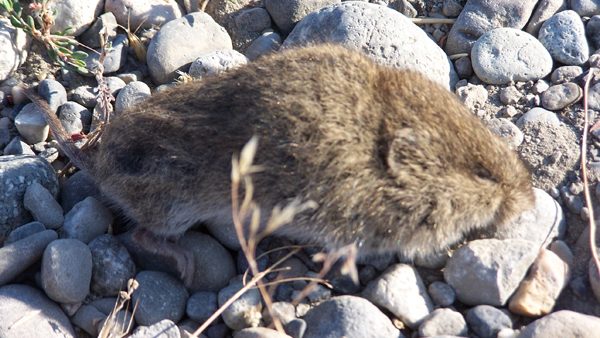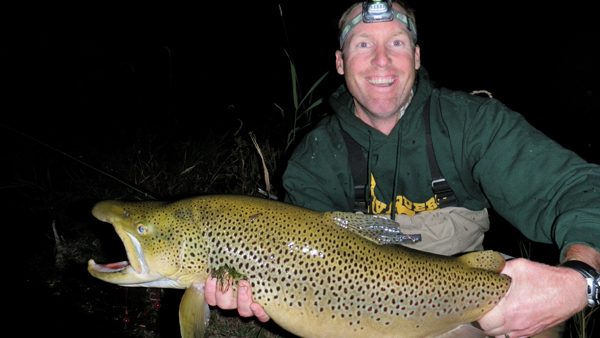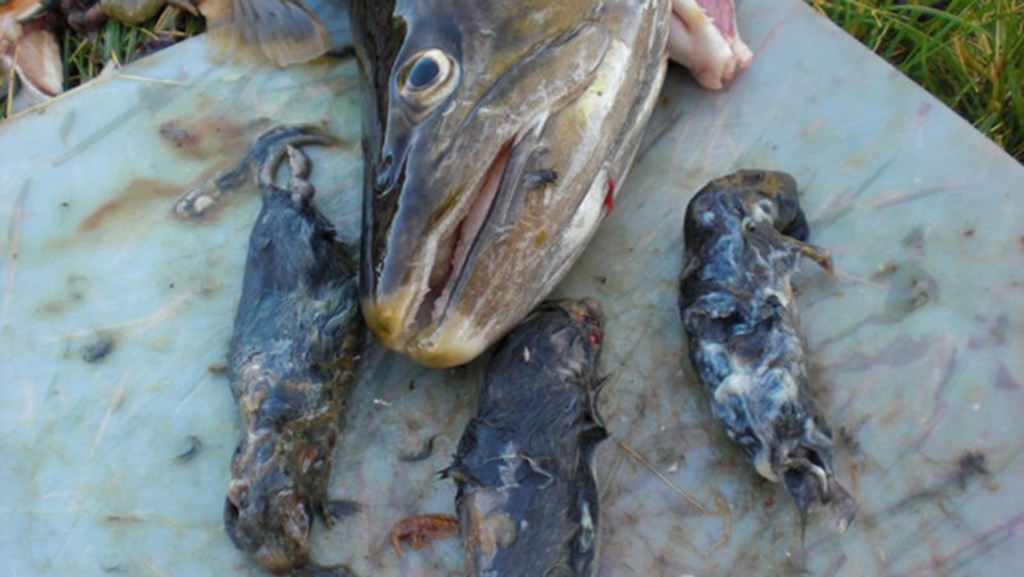As an avid fly fisher, I had heard the stories.
By day, the trout of Silver Creek—a clear, spring-fed stream in southern Idaho—fed on tiny mayflies and caddis flies. The water dimpled as trout sipped the profuse insect life from the surface. People like me used equally tiny artificial flies to try to mimic said insects, often an exercise in extreme frustration.
By night, though, river monsters ruled: giant brown trout cruised the depths, occasionally surfacing to gulp down any hapless rodents that fell into the stream.
There’s something appealing, at least to an angler, about a trout that attacks mammals. Maybe it’s the thought of our favorite water transforming into a scene from Jaws.
Maybe it’s an antidote to the frustrations of tying delicate flies that practically require a microscope: If I came back at night, I could just chuck a giant hairball!
There’s something appealing, at least to an angler, about a trout that attacks mammals.
Matt Miller
But these mice-gulping trout always carried a strong whiff of, well, the classic fishing story. High on drama. Short on fact.
Silver Creek, after all, is one of the most-studied trout streams in the world. And there were no confirmed reports of trout dining on rodents.
Silver Creek also has one of the highest densities of aquatic invertebrates anywhere. The trout surely had easier prey than the occasional mouse.
Then biologists examined some brown trout stomachs.
What they found wasn’t pretty.
But it sure did validate some heretofore questionable fishing stories.

Shocking Trout Yields a Shocking Discovery
The Nature Conservancy, who owns Silver Creek Preserve, is constantly working with agencies and biologists to study aspects of Silver Creek ranging from water quality to bird populations to vegetation patterns.
One of the regular studies is a trout population survey. Biologists and interns stand in the stream and send electric voltage into the water, a technique known as electrofishing. The trout surface, stunned by the current, and are netted. They are weighed, measured and, for the most part, released.
These surveys help biologists determine the overall trout population, its age structure and the ratio of rainbow trout to non-native brown trout.
During each trout survey, the researchers sample the contents of select trout stomachs see what they have been eating.
And as they opened brown trout stomachs they found them: montane voles, small, cigar-shaped rodents that are common along Silver Creek. One trout, pictured in this blog, had three fresh voles in its stomach.
It’s not a very appetizing picture, unless, perhaps, you’re a night-time fly fisher.

Vole Patrol
The year this survey occurred an unusual phenomenon was happening at Silver Creek. The vole population exploded.
These rodents have population cycle booms and busts, much like their better-known relatives, the lemmings.
There were voles everywhere—you’d see them in fields, in sagebrush, running across roads. One night, I took a dark walk through the preserve and constantly heard the click-click-click of tiny teeth, as thousands of voles fed on grass.
I had started to hear stories that fly fishers were catching truly monstrous brown trout by using vole patterns. But again, there was no actual verification of this – and it was so often second-hand information, a story passed on by someone’s friend or uncle.
It made sense, of course. The vole explosion was like a small-scale Serengeti. On land, there were many scenes of carnage as coyotes, weasels, hawks, owls and rattlesnakes devoured the rodent hordes. Why wouldn’t an aquatic predator do the same?
The trout stomach samples backed this up. Do brown trout feed on rodents when there isn’t a huge vole population?
It’s likely just as anglers say: when a small mouse falls into the stream, brown trout emerge from the depths and devour it.
Science is not about anecdotes, of course. But keen observers of the natural world—be they fishers or birders or urban walkers—still can contribute to our knowledge and assist conservation efforts.
Watch carefully, note your sightings and share. Strive for detail. Your observations may be an interesting side note, like the trout dining on voles. Or they could lead to important conservation actions.
In the evenings when I’m visiting Silver Creek Preserve, I like to walk along the paths, listening to night sounds. Sometimes I hear a slight commotion on the edge of the water. I imagine the little rodent struggling for shore, for an overhanging limb, anything to get out of the terrifying water world, where monsters wait.
I also know now what invariably follows. A loud, violent splash.
Then silence.
As I continue on my way, I wonder what other secrets are hidden here at the creek, secrets that can be revealed not only by scientists, but by anyone willing to watch and listen.





Are Sparkling trout rare?
Zeke,
Thanks for your question. I have not heard of sparkling trout. This is likely a local name used by anglers (there are many such names for various trout species). Do you have more information?
Matt Miller
Great bit of research! I live on the White River here in Vermont not far from the junction with the Connecticut. A lot of the water is big and every kind of fish under the sun is represented. I fish at night often in pools 20 ft deep with rainbow trout of good size feeding on top. Most of the fish are over 12 inches and 18″-20″ trout on dry flies are common. On occasion I have hooked larger fish but lost them. I have seen a gray squirrel swim across the Connecticut River at almost dark one summer evening but he was unharmed. I don’t know if I should head to the smaller tributaries to seek a big brown or continue to fish the big deep H2O from shore but for sure I will be trying mice flies.
In your testing did you identify a time of night, a temperature air and H2O? How about month of the year that surface feeding on mice occurs?
Thanks for a great article!
20 years ago I was in the town of Thurles in Tipperary Ireland. The River Suir runs through Thurles and at the bridge, is a bird sanctuary. across the street is a Chinese restaurant and at that time it was still a pretty novel thing in rural Ireland. Ducks from the sanctuary started coming up missing shortly after the restaurant opened and of course rumors started that they were the culprit. As the story traveled, a local angler decided to investigate and went down to the river one evening and verified his theory. The next day he pulled a massive pike from the river just down from the sanctuary and showed it off. low and behold, the ducks quit disappearing.
Oh my goodness, that is really something. But, is that a fingertip in the lower middle of the photo??
About 12 years ago while fishing the “Box Canyons” in the Rio Grande, above Creede Colorado, I caught a 17″ brown for dinner. WhenI gutted him, he had a pretty fresh mouse in his gut. I have the picture somewhere, but my daughter and son in law also witnessed the event. Why not a mouse? Maybe better protein than bugs.
Brian: Really great to hear from you. Strangely, I was sorting through books the other day and realized I had a book you had loaned me. I understand the hold Silver Creek has very well. Thanks for writing and tight lines!
Stephen: Great to hear from you and hope we can meet on one of my trips to Silver Creek.
Raymond: Yes, those stories always sound like tall tales, but any more I’m inclined to believe them!
Matt, it’s great to see this story, and to see that you are still part of the TNC Team. It’s hard to believe that I worked with you and Mark 10 YEARS AGO. Time flies.
My wife and I saw Mark the morning after catching that fish. I don’t think he had wiped the grin off his face yet, and I perceived that he was trembling slightly. It could have been the sleep-deprivation or cold morning, but I would like to think it was a fishing adrenaline rush that he carried for weeks.
I miss Silver Creek almost every day. I appreciate you taking me back there with this post. All the best.
When I was 15, and old miner in the Sierra Nevadas told me a story of how he caught such big German Brown trout and it was basically with like the above. He would catch small mice alive in his cabin on his mining claim and save them till he could go fishing. He said he used a piece of roof wooden tile big enough to float the mouse and would put a treble hook on the end of his line, put it under the mouses body, put the mouse on the piece of wood which had a long piece of fishing line attached to it. He would put the mouse on it just before dark and float the mouse down the stream and the when it was where he figured it was deep enough and the right place, he would pull the raft quickly from under the mouse and the mouse would have to start swimming toward shore in the current. There would be a big gulp and splash and the mouse was gone and the guy would set the hook attached to the mouse. I never personally got to see him do this but he had some of the biggest browns I had seen in the area and more than anyone else I know who fished up in that region. I believe him, but you can take it for what it is worth.
Very nice article, Matt! I bought Aubrey Spring Ranch last year, with a stretch of Loving Creek downstream from the hatchery. Good fishing. Let me know if you’re in the area.
Always A Mouse Fly For Big Trout !